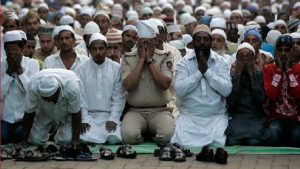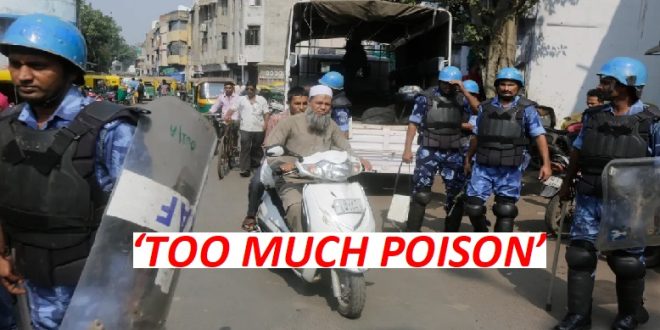27-01-2024
Bureau Report + Agencies
NEW DELHI/ MUMBAI: Driving through the Mira Road neighborhood of Mumbai was a usual affair for 21-year-old Mohammad Tariq, who ran errands on his father’s white loading auto carrier but on Tuesday, participants in a Hindu nationalist rally stopped the vehicle in the middle of the road. Young boys mostly teenagers dragged him out. They punched and kicked him and thrashed him with batons, flag staffs and iron chains, his 54-year-old father, Abdul Haque told media. Since then, Haque said, “(Tariq) has been terrified.”
 The rally, which was shared over multiple live streams, turned into a mob, targeting several Muslims in the locality, rampaging through their shops and damaging vehicles while chanting “Jai Shri Ram” (Victory to Lord Ram). Similar rallies, often to the beat of booming far-right pop music, took place outside mosques and Muslim neighborhoods across several states in India.
The rally, which was shared over multiple live streams, turned into a mob, targeting several Muslims in the locality, rampaging through their shops and damaging vehicles while chanting “Jai Shri Ram” (Victory to Lord Ram). Similar rallies, often to the beat of booming far-right pop music, took place outside mosques and Muslim neighborhoods across several states in India.
The trigger was the consecration of a Ram temple in the ancient city of Ayodhya in northern India by Prime Minister Narendra Modi on Monday. The temple is being built on the site where the 16th century Babri Masjid stood until 1992, when Hindu far-right mobs tore down the mosque, triggering nationwide riots that killed more than 2,000 people, mostly Muslims.
Addressing the country from Ayodhya, Modi said that the “wheel of time” had turned, rejecting criticism over the increased religious tensions that have been simmering in India since he came to power in 2014. “Ram is not a problem but a solution,” he said. “We are laying the foundation of India for the next 1,000 years. We take a pledge to build a capable, grand, divine India from this moment.”
Yet, as India celebrates its Republic Day on January 26, the inauguration of the temple, the Indian state’s role in it, and the violence and vandalism that religious minorities have faced since then are, to many, markers of a country that has moved away from the Constitution adopted this day in 1950.
 Soon after the consecration, a Muslim graveyard was set ablaze in the north Indian state of Bihar, a Muslim man was paraded naked in southern India, and a saffron flag representing militant Hinduism was hoisted atop a church in central India.
Soon after the consecration, a Muslim graveyard was set ablaze in the north Indian state of Bihar, a Muslim man was paraded naked in southern India, and a saffron flag representing militant Hinduism was hoisted atop a church in central India.
“This country is increasingly unrecognizable to me, where Muslims are like rubbish for them,” said Haque, on his way to a police station with his son after the Tuesday attack. “There were so many people (during the Mira Road attack) but no one stopped them from beating my child. It is shameful for society. It is a city of the blind.”
The national broadcast of the temple inauguration, including the unveiling of the idol of Ram, brought India to a halt on Monday morning. Large LED screens were set up in villages, and people gathered at temples with their families to watch the ceremony live.
Polarising speeches by Modi and his colleagues were broadcast in cinema theatres and on YouTube. Nilanjan Mukhopadhyay, an author and Modi’s biographer, noted that the event cast the prime minister as “the high priest of Hinduism”.
 Pressmediaofindia
Pressmediaofindia




